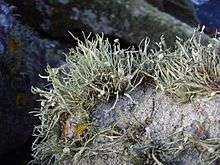Ramalina siliquosa
Ramalina siliquosa, also known as sea ivory, is a tufted and branched lichen which is widely found on siliceous rocks and stone walls on coastlands round the British Isles, occasionally slightly inland. It grows well above the high-tide mark but is still very tolerant of salt spray. The branches are flattened and grey, and bear disc-like spore-producing bodies. It forms part of the diet of sheep in Shetland and on the coast of North Wales.[2] It is found in Iceland where it has a conservation status of a vulnerable species.[3]
| Ramalina siliquosa | |
|---|---|
 | |
| Scientific classification | |
| Kingdom: | |
| Division: | |
| Class: | |
| Order: | |
| Family: | |
| Genus: | |
| Species: | R. siliquosa |
| Binomial name | |
| Ramalina siliquosa | |
| Synonyms[1] | |
|
Lichen siliquosus Huds. (1762) | |
Taxonomy
The species was originally described as Lichen siliquosus by the botanist William Hudson in 1762.[4] It was transferred to the genus Ramalina by Annie Lorrain Smith in 1918.[5]
gollark: <@!235768051683950593> It's basically impossible to make working DRM in CC.
gollark: And hope someone types them in.
gollark: I was thinking more "send commands to run it".
gollark: Can I send potatOS?
gollark: Oh, also make it emulate a Pentium 4.
References
- "Ramalina siliquosa (Huds.) A.L. Sm. 1918". MycoBank. International Mycological Association. Retrieved 2011-06-08.
- "Sea ivory - Ramalina siliquosa". MarLIN. The Marine Life Information Network. Retrieved 2013-10-19.
- Icelandic Institute of Natural History (1996). Válisti 1: Plöntur (in Icelandic). Reykjavík: Náttúrufræðistofnun Íslands.
- Hudson W. (1762). Flora Anglica (in Latin). p. 460.
- Smith AL. (1918). A Monograph of the British Lichens. 1 (2 ed.). p. 172.
This article is issued from Wikipedia. The text is licensed under Creative Commons - Attribution - Sharealike. Additional terms may apply for the media files.